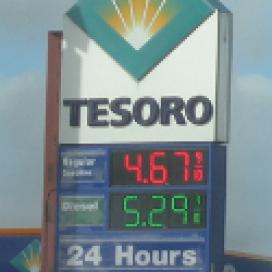CAFE Program Advances U.S. Energy and Environmental Goals
It's a myth that fuel economy standards are new, says Kevin Green, head of the Corporate Average Fuel Economy (CAFE) program office at Volpe, the National Transportation Center. Mandated by Congress, CAFE standards debuted in 1975. Fuel economy increases achieved by these standards saved the nation about 60 billion gallons of fuel in 2012.
CAFE standards apply to each manufacturer's fleet of cars for a given model year. A manufacturer's corporate average fuel economy depends on the individual ratings for each car model and the number of individual units of that model that are produced.
"So, for example, GM can keep making Corvettes with big V-8 engines, but they have to sell other models as well," explained Green at a recent Transportation Trajectories lecture at Volpe. "They just have to make sure that the overall mix of vehicles they produce and sell is sufficient, on average, to meet the standards."
CAFE Standards Today
In 2007, Congress passed legislation requiring that the National Highway Traffic Safety Administration (NHTSA) make CAFE standards depend on vehicle attributes. The standards now depend on the sizes of vehicles manufacturers produce. NHTSA hopes this change to "attribute-based" standards will discourage manufacturers from using vehicle downsizing as a way to comply. "We care about that because, if you hold everything else equal, a car tends to offer less occupant protection as it gets smaller," said Green. This change is intended to balance requirements more equitably, so that a manufacturer producing a broad mix of vehicles doesn't have to achieve as high a CAFE level as a manufacturer that offers only small cars.
"Small" and "large," in this case, is based on vehicle footprint. "It's basically the area of a rectangle under the car, with the tires as the corners of the rectangle," Green said. As required by Congress, NHTSA establishes different standards for passenger cars and light trucks, considering that fuel economy differs between the two vehicle classes.
Congress requires that NHTSA publish standards for five model years at a time. The most recently published standards cover model years 2017 through 2021. The 2021 standards are 38 to 51 miles per gallon (mpg) for cars and 25 to 42 mpg for light trucks. Based on a recent forecast of the future light-vehicle market, Volpe and NHTSA have estimated that the 2021 standards could average about 40 mpg. Even though it will cost more for cars and light trucks to achieve these standards, NHTSA and Volpe have estimated that savings in fuel cost will more than offset the increase in purchase price.
Green stressed that fuel economy is not an end in and of itself: the objective is energy conservation. While saving billions of gallons of gasoline each year, CAFE standards are also preventing huge quantities of CO2 emissions—about 650 billion tons in 2012 alone.
In a 2012 environmental impact statement supporting CAFE standards, NHTSA reported that the newest standards will have prevented a sea level rise of roughly 1/20 inch by the end of the century. It may not sound like much, but CAFE standards have achieved more to reduce greenhouse gas emissions than any other U.S. regulatory program to date.
To learn more, see video highlights of Green's talk.

